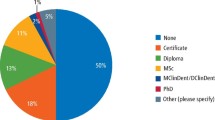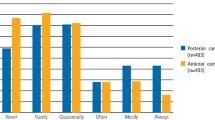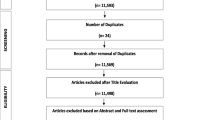Abstract
Background
Isolation with cotton rolls does not always provide as complete isolation as rubber dam, especially in procedures where absolute moisture control is critical. Therefore, this review aims to summarize and analyze previous studies evaluating the retention and marginal integrity of pit & fissure sealant using rubber dam and cotton roll isolation techniques during dental treatment in children.
Material and methods
In accordance with PRISMA guidelines, search yielded 1361 articles, with seven RCTs and one non-RCT design meeting the inclusion criteria. Data were extracted on study design, sample size, sealant type, follow-up duration, retention rates, and caries incidence.
Results
The comparison of retention rate between rubber dam and cotton roll at six months difference was non-significant (OR:1.15; p = 0.64) while there was significant difference at 12 month (OR:2.23; p < 0.001). The difference for the marginal integrity was statistically significant at six months (OR:2.00; p = 0.03) while non-significant difference observed (OR:1.74; p = 0.10) at 12 months.
Conclusion
The sealant placed using a rubber dam as an isolation technique showed higher retention than the cotton roll after 12 months. In terms of marginal integrity, the performance of the rubber dam and cotton roll was equivalent at the end of 12 months.
This is a preview of subscription content, access via your institution
Access options
Subscribe to this journal
Receive 4 print issues and online access
$259.00 per year
only $64.75 per issue
Buy this article
- Purchase on SpringerLink
- Instant access to full article PDF
Prices may be subject to local taxes which are calculated during checkout





Similar content being viewed by others
Data availability
The authors confirm that the data supporting the findings of this study are available within the article and further inquiries can be directed to the corresponding author.
References
Bandi M, Mallineni S, Nuvvula S. Influence of isolation methods on retention of Pit and Fissure Sealants in young permanent teeth based on Simonsen’s Criteria: A randomised clinical trial. J Clin Diagn Res. 2021;15:ZC06–9.
Mattar RE, Sulimany AM, Binsaleh SS, Hamdan HM, Al-Majed IM. Evaluation of fissure sealant retention rates using Isolite in comparison with rubber dam and cotton roll isolation techniques: A randomized clinical trial. Int J Paediatr Dent. 2023;33:12–9.
Straffon LH, Joseph B, Dennison JB, More FG. Three-year evaluation of sealant: Effect of isolation on efficacy. JADA. 1985;110:714–7.
Nikiforuk G Understanding dental caries. New York:Karger. 1985: 261–93.
Ganesh M, Tondon M. Clinical evaluation of FUJI VII Sealant material. J Pediatr Dent. 2006;31:52–7.
Ganss C, Klimek J, Gleim A. One year clinical evaluation of the retention and quality of two fluoride-releasing sealants. Clin Oral Investig. 1999;3:188–93.
Lygidakis NA, Oulis KI, Chirtodonlidis A. Evaluation of fissure sealants retention following four different isolation and surface preparation techniques: four years clinical trial. J Clin Paediatr Dent. 1994;19:23–5.
Cortez TV, Godoy EP, Paschoini VL, Corona SAM, Borsatto MC, Souza‑Gabrie AE. Clinical performance of sealants under different humidity control conditions: a split‑mouth 1‑year randomized trial. Eur Arch Paediatr Dent. 2023;24:769–77.
Mattar RE, Sulimany AM, Binsaleh SS, Hamdan HM, Al-Majed IM. Comparison of fissure sealant chair time and patients preference using three different isolation techniques. J Child. 2021;8:2–9.
Bandi M, Sreekanth KMallineni, Nuvvula SK. Retention and effectiveness of pit and fissure sealants placed with or without bonding agent in young permanent teeth: a randomized clinical trial with a year follow‑up. Indian J Dent Res. 2021;31:878–82.
Raadal M, Laegreid O, Laegreid KV, Hveem H, Korsgaard EK, Wangen K. Fissure sealing of permanent first molars in children receiving a high standard of prophylactic care. Community Dent Oral Epidemiol. 1984;12:65–8.
https://www.prisma-statement.org/prisma-2020-checklist PRISMA 2020 Checklist
https://www.crd.york.ac.uk/prospero/display_record.php?ID=CRD42024518973 PROSPERO database Ref.no: CRD42024502571
Barroso JM, Torres CP, Lessa FCR, Pecora JD, Palma-Dibb RG, Borsatto MC. Shear bond strength of pit-and-fissure sealants to saliva contaminated and noncontaminated enamel. J Dent Child. 2005;72:95–9.
Francis R, Mascarenhas AK, Soparkar P,Mutawaa SAL. Retention and effectiveness of fissure sealants in Kuwaiti school children. Community Dent Health. 2008;25:211–5.
Ng TC, Chu CH, Yu OY. A concise review of dental sealants in caries management. Front Oral Health. 2023;4:1–11.
Ahovuo‑Saloranta A, Forss H, Hiiri A, Nordblad A, Makela M. Pit and fissure sealants versus fluoride varnishes for preventing dental decay in the permanent teeth of children and adolescents. Cochrane Database Syst Rev. 2016;18:CD003067.
Handelman SL. Therapeutic use of sealants for incipient or early carious lesions in children and young adults. Proc Finn Dent Soc. 1991;87:463–75.
Hyun YS, Kim SY, Lee YJ, Park JE. RoBANS 2: A revised risk of bias assessment tool for nonrandomized studies of interventions. Korean J Fam Med. 2023;44:249–60.
Mertz‑Fairhurst EJ, Schuster GS, Fairhurst CW. Arresting caries by sealants: Results of a clinical study. J Am Dent Assoc. 1986;112:194–7.
Bagher SM, Sabbagh HJ. A literature review of clinical efficiency, patient satisfaction, and future preference of Isolite and Dry Shield dental isolation systems among pediatric patients. J Clin Pediatr Dent. 2023;47:1–8.
Sterne JA, Sutton AJ, Ioannidis JP, Terrin N, Jones DR, Lau J, et al. Recommendations for examining and interpreting funnel plot asymmetry in meta-analyses of randomised controlled trials. Bmj. 2011;343:d4002.
Eskandarian T, Baghi S, Alipoor A. Comparison of clinical success of applying a kind of fissure sealant on the lower permanent molar teeth in dry and wet conditions. J Dent Iran. 2015;16:162–8.
Oba AA, Dulgergil T, Sonmez IS, Doğan S. Comparison of caries prevention with glass ionomer and composite resin fissure sealants. J Formos Med Assoc. 2009;108:844–8.
Ulusu T, Odabaş ME, Tuzuner T, Baygin O, Sillelioğlu H, Deveci C, et al. The success rates of a glass ionomer cement and a resinbased fissure sealant placed by fifth-year undergraduate dental students. Eur Arch Paediatr Dent. 2012;13:94–7.
Buonocore MG. Simple method of increasing the adhesion of acrylic filling materials to enamel surfaces. J Dent Res. 1995;34:849–53.
Symons AL, Chu CY, Meyers IA. The effect of fissure morphology and pretreatment of the enamel surface on penetration and adhesion of fissure sealants. J Oral Rehabil. 1996;23:791–98.
Mejare I, Lingstrom P, Petersson LG, Holm AK, Twetman S, Kallestal C, et al. Caries‑preventive effect of fissure sealants: A systematic review. Acta Odontol Scand. 2003;61:321–30.
Mascarenhas AK, Nazar H, Mutawaa S, Soparkar P. Effectiveness of primer and bond in sealant retention and caries prevention. Pediatr Dent. 2008;30:25–8.
Patil SB, Shivakumar AT, Shah S. Effect of salivary contamination on shear bond strength of two adhesives: An in vitro study. Dent Hypotheses. 2014;5:115–20.
Tulunoglu O, Bodur H, Uctasli M, Alacam A. The effect of bonding agents on the microleakage and bond strength of sealant in primary teeth. J Oral Rehabil. 1999;26:436–41.
Topaloglu Ak A, Riza Alpoz A. Effect of saliva contamination on microleakage of three different pit and fissure sealants. Eur J Paediatr Dent. 2010;11:93–6.
Mallineni SK, Yiu CK. A Retrospective audit of dental treatment provided to special needs patients under general anesthesia during a ten-year period. J Clin Pediatr Dent. 2018;42:155–60.
Hormati AA, Fuller JL, Denehy GE. Effects of contamination and mechanical disturbance on the quality of acid-etched enamel. J Am Dent Assoc. 1980;100:34–8.
Bagher SM, Sabbagh HJ. A literature review of clinical efficiency, patient satisfaction, and future preference of Isolite and DryShield dental isolation systems among pediatric patients. J Clin Pediatr Dent. 2023;47:1–8.
Funding
The authors received no specific funding for this work.
Author information
Authors and Affiliations
Contributions
Neha Shukla: Conceptualization, Data curation, Formal analysis, Methodology, Visualization, Writing – original draft. Mahesh Khairnar: Data curation, Formal analysis, Methodology, Writing – review & editing. P G Naveen Kumar: Data curation, Formal analysis, Writing – review & editing. Sachin Kumar Jadhav: Data curation, Methodology, Writing – review & editing. Zainab Akram: Conceptualization, Methodology, Visualization, Writing – review & editing. Savitha Priyadarsini: Data curation, Methodology, Writing – review & editing.
Corresponding author
Ethics declarations
Competing interests
The authors declare no competing interests.
Additional information
Publisher’s note Springer Nature remains neutral with regard to jurisdictional claims in published maps and institutional affiliations.
Rights and permissions
Springer Nature or its licensor (e.g. a society or other partner) holds exclusive rights to this article under a publishing agreement with the author(s) or other rightsholder(s); author self-archiving of the accepted manuscript version of this article is solely governed by the terms of such publishing agreement and applicable law.
About this article
Cite this article
Shukla, N., Akram, Z., Kumar, P.G.N. et al. Comparative evaluation of pit & fissure sealant retention using cotton roll & rubber dam isolation techniques – a systematic review & meta-analysis. Evid Based Dent 26, 112 (2025). https://doi.org/10.1038/s41432-024-01092-6
Received:
Accepted:
Published:
Issue date:
DOI: https://doi.org/10.1038/s41432-024-01092-6
This article is cited by
-
Sealant retention, patient satisfaction, and operator preference: a split-mouth randomised controlled trial comparing EasyPrep® and cotton roll isolation in a dental school setting
European Archives of Paediatric Dentistry (2025)



